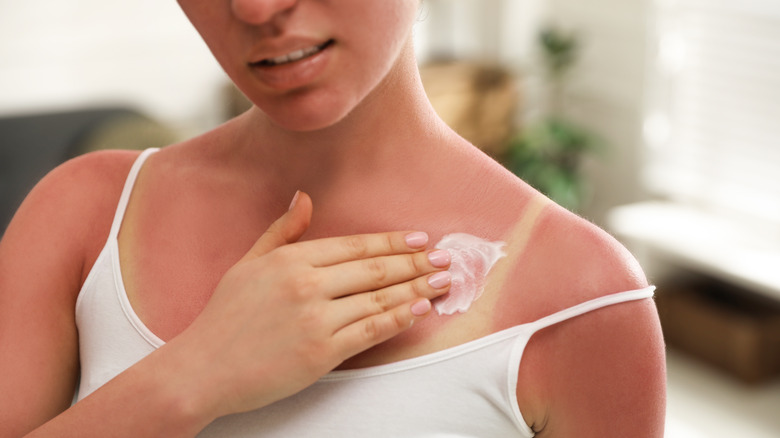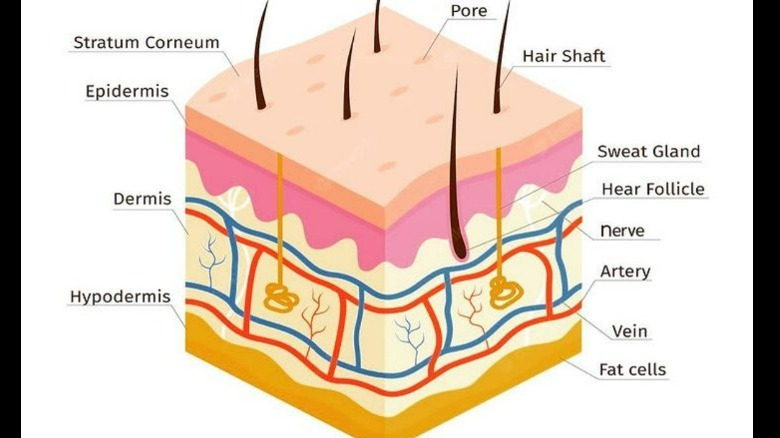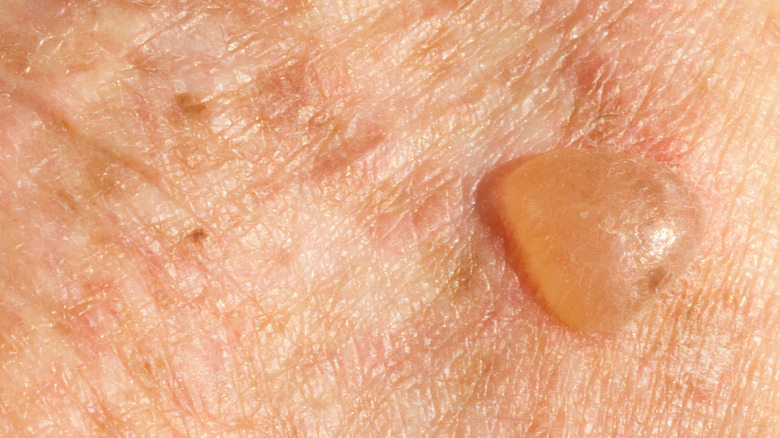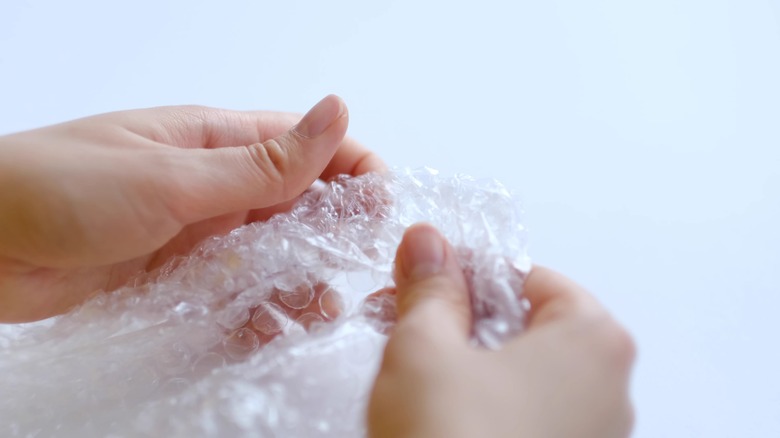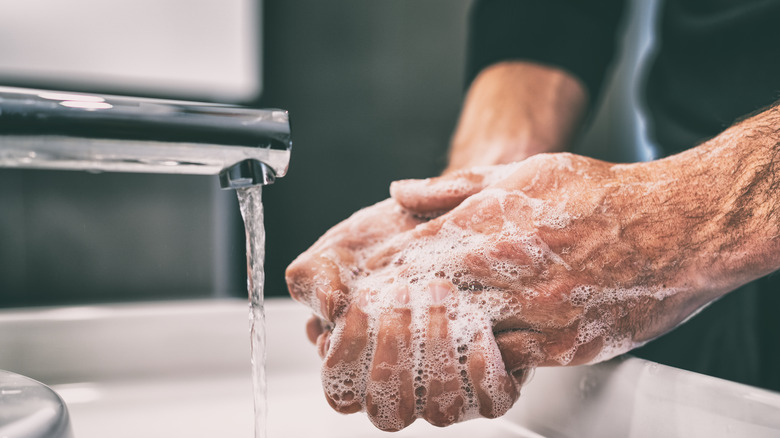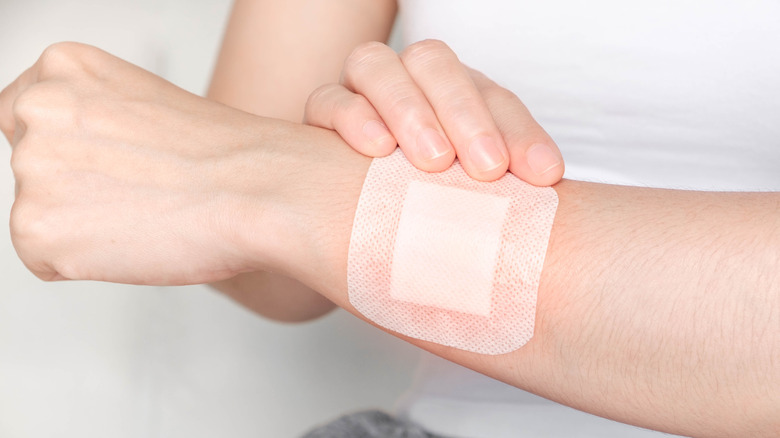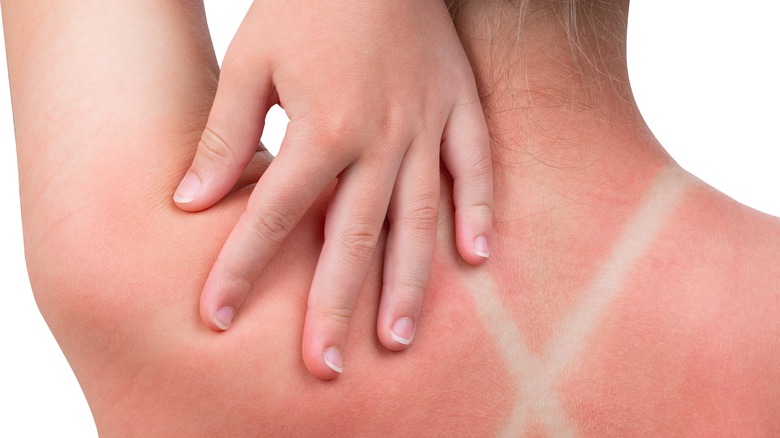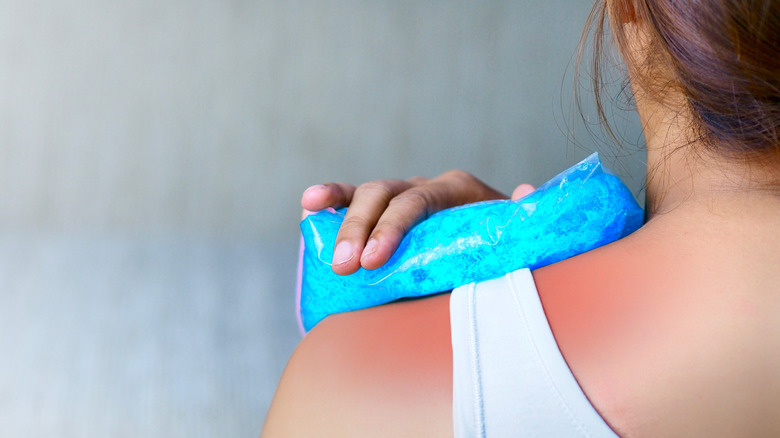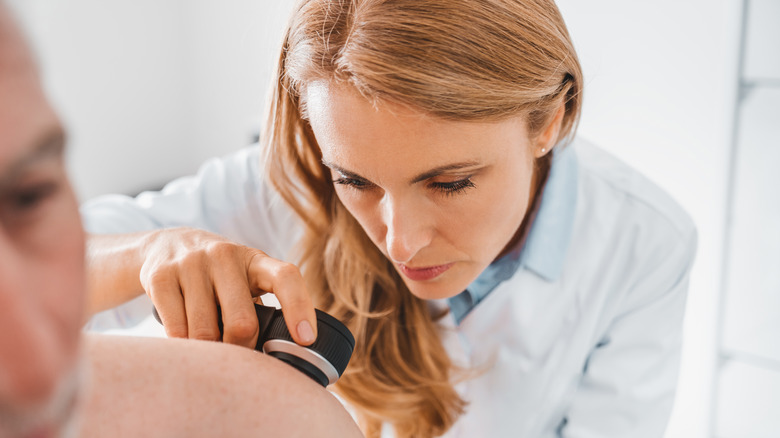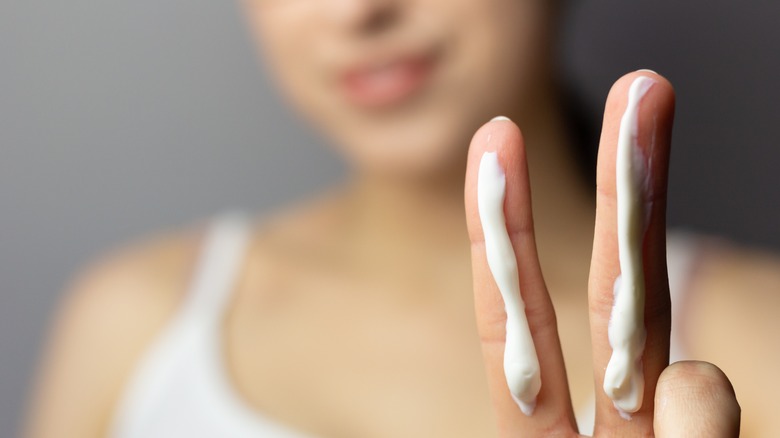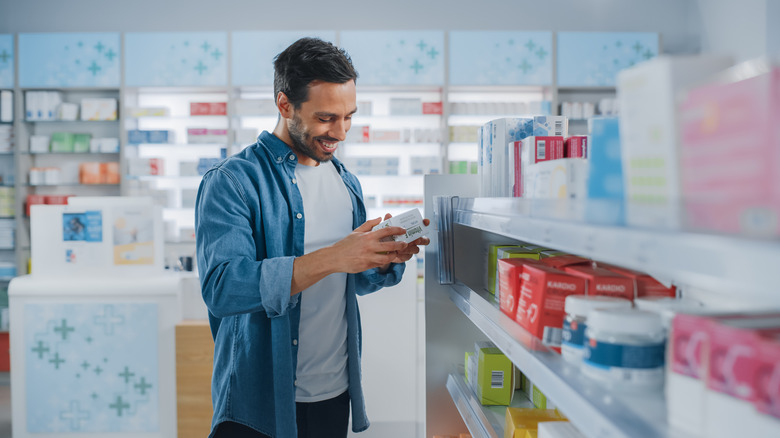Is It Normal To Get Blisters After A Sunburn?
Sunburn blisters are small, fluid-filled pockets that bulge from the top layer of sunburned skin, according to Healthline. Sunburn itself isn't a "normal" state, at least not according to the Skin Cancer Foundation. Rather, "sunburn is a radiation burn to the skin caused by too much exposure to the sun's ultraviolet (UV) rays or artificial sources such as tanning beds," per Sunburn. Well, at least it starts that way. As the Skin Cancer Foundation points out, sunburn may feel like a short-term problem, but it's actually a set-up for various forms of skin cancer, given that most cases can be traced to sunburn. Sunburns also lead to premature aging of the skin, including wrinkles and age spots.
It is technically "normal" to get blisters after a sunburn, albeit in the same way that it's normal to get a hangover after a night of drinking. In other words, although a blistering sunburn is a normal reaction to overexposure to the sun's rays (or the tanning bed equivalent), what it actually means is that you've spent too much time in the sun for your particular level of sun tolerance, without adequate protection. More specifically, it means that UV radiation has damaged your skin to the level of a second-degree burn, according to the Burn and Reconstructive Centers of America (BRCA).
What causes sunburn blisters?
"When ultraviolet radiation from the sun reaches the skin, it damages the skin cells," according to Dr. Saira George of the MD Anderson Cancer Center. A first-degree sunburn is a superficial injury that affects the epidermis, which is the top layer of the skin, per Children's Hospital of Philadelphia. A blistering sunburn, by contrast, is not superficial. It affects not only the epidermis but also the dermis, which is the inner layer of skin, whose job is to protect the fat and connective tissue beneath it (i.e., the hypodermis), per the National Cancer Institute.
When a sunburn blisters, that means the "deep skin layers and nerve endings have been damaged," according to Alberta Health. Blisters, which tend to appear in response to sunburn within six to 24 hours after last sun exposure (via Healthline), form because inflammatory damage from UV rays can cause the two aforementioned layers of the skin to separate from one another. As New York City dermatologist Joshua Zeichner tells Prevention, "Sun blisters develop when the skin becomes so inflamed that connections between skin cells become disrupted. This leads to splitting of the skin, which ultimately fills with serous fluid."
What is inside a sunburn blister?
UV rays are damaging to skin cells, according to the Skin Cancer Foundation. In a blistering sunburn, the damage is severe enough to cause layers of the skin to separate from one another, whether within the epidermis or between the epidermis and the dermis (i.e., the inner layer of skin) according to Britannica, but since nature abhors a vacuum, your body isn't going to stand for having one layer of your skin split away from another without rushing in to fill the breach — and literally at that. It does so by immediately filling the pocket formed by this process with a substance called serous fluid, according to Zeichner.
Serous fluid comes from the liquid portion of the blood, and it leaks in from "neighboring tissues as a reaction to injured skin," according to Harvard Health Publishing. As long as the top layer of the blister remains intact, the serous fluid acts as a protective layer for the tissue beneath it. If blistered skin becomes infected, the fluid may be tinged with blood and/or pus, per the National Health Service (NHS). And even if a blister ruptures, the serous fluid continues to leak into the sun-damaged tissue to bathe it and protect it as it heals, until the healing process is complete, per Healthline.
Should you pop sunburn blisters?
The first rule of sunburn blisters is you don't pop sunburn blisters, according to many dermatologists. "Think of the top of the blister like nature's Band-Aid, protecting the raw skin underneath," says Dr. Joshua Zeichner to Prevention. Indeed, "blisters should be allowed to drain and pop by themselves," as assistant clinical professor of dermatology at the Icahn School of Medicine at Mount Sinai Hospital, Gary Goldenberg, adds (via Prevention).
Nevertheless, not all dermatologists are on the same page, according to the BRCA. Rather, some believe that leaving the sunburn blister intact may allow the fluid inside it to become stagnant, which can breed infection, However, there is little to no scientific evidence that serous fluid is prone to becoming stagnant in people with no underlying circulatory issues (per ScienceDirect). By contrast, in people with diabetes, which can impair circulation (via Amputation Prevention Centers of America), blisters may be more prone to infection even while still intact (via Healthline). On the other hand, opening a blister exposes the underlying injury to pathogens, including bacteria. Accordingly, the BRCA suggests that, as a general matter, it's best to leave a blister intact as it heals.
What should you do if your sunburn blister(s) pop?
"While some believe stagnant fluid breeds infection, an open wound opens the door for harmful bacterial colonization," according to the BRCA. That's why it's common for dermatologists to recommend leaving the blister intact. Nevertheless, blisters have been known to break of their own volition. In that case, "proper wound care and good hygiene" may go a long way toward preventing infection and further inflammation.
Indeed, the BRCA says that for a broken blister, "your main goal should be to keep the wound bed as sterile and debris-free as possible." Specifically, that means avoiding touching it — that's true even if it is intact, of course — and washing your hands thoroughly with soap and water before going anywhere near it with your hands. Once your hands are clean, you should gently but thoroughly clean the open blister with warm water and soap. Then spread some antibacterial ointment on a sterile bandage and use that to cover the open blister. Alternatively, you can use a hydrocolloid dressing, which can be a more streamlined alternative to a bandage with ointment, per NHS. Repeat this process every time the bandage becomes wet or dirty, and in any event, no less than once per day.
Should you cover blisters?
Just as there is some debate among experts about whether or not to pop a sunburn blister, there's also some disagreement over whether or not to cover a sunburn blister with a bandage or other protective dressing, according to BRCA. If your blister has not popped, you may wish to just leave it alone rather than taking a chance on dressing it, as doing so does increase the likelihood that you'll break the blister. On the other hand, that shouldn't be interpreted to mean that you should not cover it. In fact, speaking to Prevention, Dr. Joshua Zeichner recommends covering most sun blisters with a dry sterile bandage so as to avoid friction from clothing or otherwise, which can cause the blister to rupture.
It's a whole different story in the event your blister has already ruptured. In such case, you'll want to wash and dress the wound. The Mayo Clinic suggests using a small, clean, sharp pair of scissors to trim the ruptured top layer of skin, although this may not be a great idea if you aren't sure how to sterilize your scissors (or if you're not even sure about the difference between sterilizing and disinfecting).
Blisters are a symptom of sun poisoning, so it may present with these symptoms
People often wonder what's the difference between sunburn and sun poisoning, so we're here to clarify that sun poisoning always involves a sunburn. As dermatologist Dr. Joshua Zeichner explains to Allure, "sun poisoning is a reaction to a severe sunburn that affects your entire body." In other words, if you have a sunburn, you may not have sun poisoning, but if you've received a clinical diagnosis of sun poisoning, then it's a certainty that you presented to your clinician with a sunburn. And if that sunburn damaged your skin to the point that you now have sun blisters, that's prima facie evidence that your sunburn is severe.
In other words, a blistering sunburn is, by definition, sun poisoning, according to WebMD. Other signs of sun poisoning include fever and malaise, chills, nausea, headache, dizziness, and dehydration. But blisters from a sunburn are enough to merit a clinical sun poisoning diagnosis (to the extent that sun poisoning can be considered a clinical diagnosis, as opposed to just a really uncomfortable reaction to a really bad sunburn, according to family medicine doctor Matthew Goldman, via Cleveland Clinic).
How to treat sun blisters if you end up getting them
If you have a sunburn blister, the treatment is fairly simple: In addition to staying out of the sun, which can make a bad sunburn worse according to Regions Hospital, you'll want to treat your sun blisters both locally and systemically, according to Prevention.
As far as local treatment goes, in most cases it's best to leave the blister(s) intact, per Mayo Clinic. Assuming your blister(s) are, in fact, intact, your best bet is to do nothing more than keep the affected skin clean, dry, and free from irritants such as hot water and harsh soaps (per Prevention). If your intact blisters are causing discomfort, you may be able to get some relief by applying cold, damp compresses. You can also try a topical steroid to help relieve itchiness and superficial inflammation. If you want to cover your intact blister with a bandage, just be sure to do so gently.
In terms of systemic treatment, whether your blister is intact or ruptured (in fact, even if your sunburn hasn't even blistered), the American Academy of Dermatology recommends drinking lots of water to prevent dehydration. The reason is that having a sunburn requires your body use more water than what it normally needs. Taking an NSAID such as ibuprofen or aspirin may help as well, per Prevention. And if your blister should pop, then clean and dress it.
How long do sunburn blisters take to heal, and when should you call a doctor?
Most sunburn blisters heal on their own with gentle treatment plus a good measure of patience, per the BRCA. Acute pain from sun blisters can improve after about 48 hours, but it can still take at least a week for sunburn blisters to resolve, according to Healthline. In addition, the BRCA advises you to consult a healthcare provider immediately in the event that the blister is large, or there are many of them (even if they're not large). And Northwestern Medicine notes that if sunburn blisters cover more than 20% of your skin, that merits a check-in with your provider.
In addition, BRCA recommends checking in with your healthcare provider if your blister hasn't healed after a week, if it begins to change color (which is to say it the fluid no longer appears "watery") or emit a foul odor, or if the skin around the edges of the blister changes, which could mean an infection known as cellulitis. Finally, Northwestern Medicine points out that if you also develop a high fever, chills, nausea, or headache — all of which suggest sun poisoning — you may need medical treatment for dehydration.
A blistering sunburn significantly increases your lifetime risk of skin cancer
It has long been known, at least among dermatologists, that UV damage is cumulative over an individual's lifetime and can continue to build up even in the absence of sunburn, let alone blistering, per the Skin Cancer Foundation. And sun damage can lead to skin cancer, according to Yale Medicine. However, whereas simple cumulative sun exposure leads mainly to basal cell and squamous cell skin cancers, according to Cleveland Clinic, blistering sunburns are more strongly associated with the development of the deadliest form of skin cancer: melanoma. And if you're older than 20 as you're reading this, the damage may already be done.
According to the Skin Cancer Foundation, a single blistering sunburn before the age of 20 has been found to more than double your lifetime risk of melanoma. A 1989 study published in the journal Pediatrics found that the risk of melanoma in adult women to be highest among those who had multiple blistering sunburns between the ages of 15 and 20. Accordingly, Yale Medicine recommends that if you experienced blistering sunburns in childhood at all, it may be a good idea to consult a dermatologist regarding not only your risk of skin cancer, but also how to detect it in its earliest stages, when it is most treatable.
How to prevent sunburn
The best way to avoid blistering from a sunburn is to avoid sunburn altogether. This is particularly true now that NASA has confirmed what many of the fair-skinned among us already were beginning to suspect, which is that the amount of UV radiation that reaches the Earth's surface has "increased markedly over the last three decades." This is believed to be the result of ongoing depletion of the ozone layer, which has been, at times, referred to as Earth's natural sunscreen, per the UK Department for Environmental Food and Rural Affairs, as well as NASA.
Although some people are at higher risk of sunburn than others, per Cancer Research UK, anyone can get sunburned. Therefore, no matter who you are and how much sun exposure you think you can handle without burning, it may be better part of caution to make a habit of avoiding direct sun exposure at times when the sun is at its highest in the sky. And you'll know if that's the case if your shadow is shorter than your height. And whenever you are going to be exposed to the sun, it's best to wear a broad-spectrum sunscreen of SPF 30 or higher (broad spectrum means it blocks both UVA and UVB rays) and reapply it every two hours, or if you get damp from swimming or sweating (via MD Anderson Cancer Center).
Medications that can make you more susceptible to blistering
Although there is no medication that will make you more susceptible to sunburn blisters, per se, a number of medications are known to cause photosensitivity. Photosensitivity is the clinical term for increased susceptibility UV light, and therefore increased chances of sunburn. And increased susceptibility to sunburn means that blistering becomes a greater risk upon sun exposure, as does the risk of skin cancer over the long term, according to Skin Cancer Prevention.
Medications that are known to cause photosensitivity include the class of antibiotics known as tetracyclines, particularly doxycycline, which is commonly used to treat UTIs, according to MediLib and Cleveland Clinic. Sulfonamides, another treatment for bacterial infections, may also cause photosensitivity. So too may certain diuretics (including the commonly prescribed furosemide, per MedlinePlus), non-steroidal anti-inflammatory drugs such as ibuprofen, and retinoids. In addition, the non-prescription dietary supplement St. John's wort, which is used by some to treat depression, is known to make those who take it more susceptible to sunburn (via RxList).
It's worth noting, however, that many other medications, both prescription and over-the-counter, may cause photosensitivity. But any that do should bear a warning label to that effect. If you see such a label, "don't ignore it," GoodRx advises.

